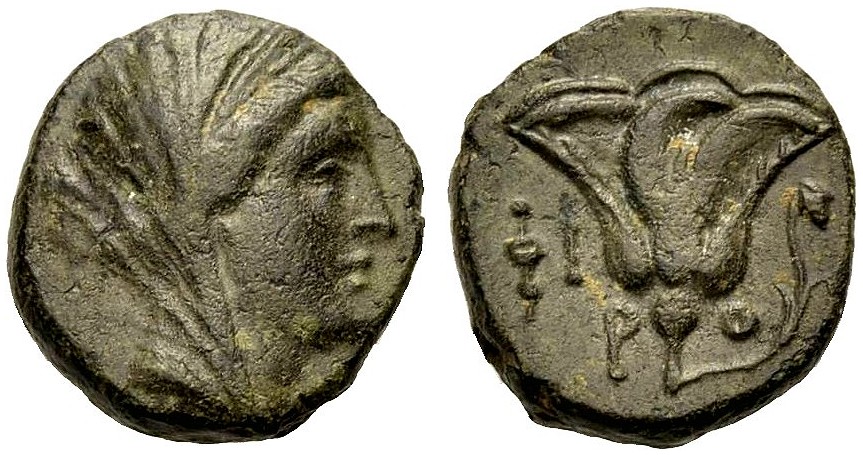Rhodes, bronze (veiled head/rose) (229-226 BCE): Difference between revisions
From SILVER
No edit summary |
No edit summary |
||
| (4 intermediate revisions by one other user not shown) | |||
| Line 7: | Line 7: | ||
|Reverse description=Rose, to r., bud | |Reverse description=Rose, to r., bud | ||
|Mint=Rhodes | |Mint=Rhodes | ||
|Ancient region=Caria ( | |Ancient region=Caria (islands) | ||
|Authority=Rhodian power | |||
|Date from=229 BCE | |Date from=229 BCE | ||
|Date to=226 BCE | |Date to=226 BCE | ||
| Line 15: | Line 16: | ||
|RQEM reference=RQEMH | |RQEM reference=RQEMH | ||
|RQEM reference number=249 | |RQEM reference number=249 | ||
|Die study reference=Ashton 1986 | |Die study reference=Ashton 1986; Ashton 2001, p. 107, n° 239-241 | ||
|Coin series reference=RQEMH, n° 249; Sear II, n° 5077 | |Coin series reference=RQEMH, n° 249; Sear II, n° 5077 | ||
|Coin series web reference=https://greekcoinage.org/iris/id/rhodes_ashton_2001_239-41 | |Coin series web reference=https://greekcoinage.org/iris/id/rhodes_ashton_2001_239-41 | ||
| Line 22: | Line 23: | ||
|Number of reverse dies=12 | |Number of reverse dies=12 | ||
|Number of coins=14 | |Number of coins=14 | ||
|Workstation=Most likely one single workstation | |||
}} | }} | ||
{{Distribution Item | {{Distribution Item | ||
Latest revision as of 19:58, 5 May 2023
229 BCE - 226 BCE Bronze
Description
| ObverseInscription or printing placed on the obverse.: | Diademed and veiled female bust (of Berenike II?) to right |
| ReverseInscription or printing placed on the reverse.: | PO (Greek).Rose, to r., bud |
Mint and issuing power
| MintIdentifies the place of manufacture or issue of a numismatic object.: | Rhodes | Ancient regionAncient region.: | Caria (islands) | Modern countryModern country: Greece | AuthorityIdentifies the issuing power. The authority can be "pretended" when the name or the portrait of X is on the coin but he/she was not the issuing power. It can also be "uncertain" when there is no mention of X on the coin but he/she was the issuing power according to the historical sources: | Rhodian power |
Chronology
| FromIdentifies the initial date in a range assigned in a numismatic context. | 229 BCE | toIdentifies the final date in a range assigned in a numismatic context.. | 226 BCE | PeriodTime period of the numismatic object.: Hellenistic 323-30 BC |
Physical description
| MetalThe physical material (usually metal) from which an object is made.: | Bronze |
Median weightMedian of the weights of numismatic objects (in grams). in grams | 2.60 | DenominationTerm indicating the value of a numismatic object. Examples: tetradrachm, chalkous, denarius.: | StandardStandard.: |
Image

H249 Rhodes Veiled head rose.jpg [1]
References
| Die study referencePublication of the study: | Ashton 19861Ashton 1986, Ashton 20012Ashton 2001, p. 107, n° 239-241 | ||
| Coin series referenceReference to coin series study: | RQEMH3RQEMH, n° 249, Sear II4Sear II, n° 5077 | ||
| Coin series web referenceCoin series web references: | |||
Obverse dies distribution
Reverse dies distribution
no distribution is available
Quantification
| Number of obversesNumber of obverse dies. ᵖ (o) | 7 | Number of singletons (o1)The number of singleton coins. ᵖ | 4 |
| Number of reverse diesNumber of reverse dies. (r) | 12 | Number of coinsNumber of coins. (n) | 14 |
| Coins per obverse dieNumber of coins per obverse die. (n/o) | 2 | Coins per reverse dieNumber of coins per reverse die. (n/r) | 1.17 |
| Reverse per obverse ratioRatio of obverse dies divided by reverse dies. (r/o) | 1.71 | Percentage of singletons (o1)number of coins (n) divided by the number of singletons (o1) ᵖ | 57.14 % |
| Original number of dies (O) (Carter 1983 formula)The estimation of the number of coins according to Carter 1983 ᵖ | 11.36 | Coins struck if 20,000 as average productivity per dieCoins made if the average productivity for obverses (according to Carter) is 20,000. ᵖ | 227,200 |
| Original number of dies (O) (Esty 2011 formula)The estimation of the number of coins according to the singleton formula in Esty 2011 ᵖ (O) | 14 | Survival rate if 20,000 as average productivity per dieSurvival rate if average productivity is 20,000. ᵖ | 0.00006 |
| Coverage (o = % of O) (Esty 1984 formula)Esty 1984 - coverage (% of O) ᵖ (o = % of O) | 71.43% | Die productivity if survival rate 1/2,000Average productivity if survival rate is 1/2,000. ᵖ | 2,464.79 |
| Weight of silver (in kg) if 20,000 coins per die (O = Carter formula)Carter 1983 * Median weight * 20000 (*10 if gold or electrum) ᵖ | n.a. | Die productivity if survival rate 1/5,000Average productivity if survival rate is 1/5,000. ᵖ | 6,161.97 |
Remarks
Most likely one single workstation